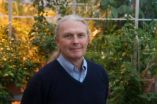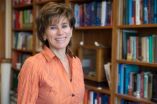(Press-News.org) ESA's GOCE gravity satellite has already delivered the most accurate gravity map of Earth, but its orbit is now being lowered in order to obtain even better results.
The Gravity field and steady-state Ocean Circulation Explorer (GOCE) has been orbiting Earth since March 2009, reaching its ambitious objective to map our planet's gravity with unrivalled precision.
Although the planned mission has been completed, the fuel consumption was much lower than anticipated because of the low solar activity over the last two years. This has enabled ESA to extend GOCE's life, improving the quality of the gravity model.
To be able to measure the strength of Earth's gravity, the satellite was flying in an extraordinarily low orbit about 255 km high – about 500 km lower than most Earth observation satellites.
Based on a clear preference from the GOCE user community, ESA's Earth Scientific Advisory Committee recommended lowering the orbit to 235 km starting in August.
Lowering the orbit increases the accuracy and resolution of GOCE's measurements, improving our view of smaller ocean dynamics such as eddy currents.
The control team began the manoeuvres in August, lowering GOCE by about 300 m per day.
After coming down by 8.6 km, the satellite's performance and new environment were assessed. Now, GOCE is again being lowered while continuing its gravity mapping. Finally, it is expected to reach 235 km in February.
As the orbit drops, atmospheric drag increasingly pulls the satellite towards Earth. But GOCE was designed to fly low, the tiny thrust of its ion engine continuously compensating for any drag.
The expected increase in data quality is so high that scientists are calling it GOCE's 'second mission.'
"For us at ESA, GOCE has been a fantastic mission and it continues to surprise us," said Volker Liebig, ESA's Director of Earth Observation Programmes.
"What the team of ESA engineers is now doing has not been done before and it poses a challenge. But it will also trigger new research in the field of gravity based on the high-resolution data we are expecting."
The first 'geoid' based on GOCE's gravity measurements was unveiled in June 2010. It is the surface of an ideal global ocean in the absence of tides and currents, shaped only by gravity.
A geoid is a crucial reference for conducting precise measurements of ocean circulation, sea-level change and ice dynamics.
The mission has also been providing new insight into air density and wind in space, and its information was recently used to produce the first global high-resolution map of the boundary between Earth's crust and mantle.
### END
GOCE's second mission improving gravity map
2012-11-16
ELSE PRESS RELEASES FROM THIS DATE:
Fear of the dentist is passed on to children by their parents
2012-11-16
Fear of visiting the dentist is a frequent problem in paediatric dentistry. A new study confirms the emotional transmission of dentist fear among family members and analyses the different roles that mothers and fathers might play.
A new study conducted by scientists at the Rey Juan Carlos University of Madrid highlights the important role that parents play in the transmission of dentist fear in their family.
Previous studies had already identified the association between the fear levels of parents and their children, but they never explored the different roles that ...
Important progress for spintronics
2012-11-16
A fundamental cornerstone for spintronics that has been missing up until now has been constructed by a team of physicists at Linköping University in Sweden. It's the world's first spin amplifier that can be used at room temperature.
Great hopes have been placed on spintronics as the next big paradigm shift in the field of electronics. Spintronics combines microelectronics, which is built on the charge of electrons, with the magnetism that originates in the electrons' spin. This lays the foundation for entirely new applications that fire the imagination. The word "spin" ...
Melt water on Mars could sustain life
2012-11-16
Near surface water has shaped the landscape of Mars. Areas of the planet's northern and southern hemispheres have alternately thawed and frozen in recent geologic history and comprise striking similarities to the landscape of Svalbard. This suggests that water has played a more extensive role than previously envisioned, and that environments capable of sustaining life could exist, according to new research from the University of Gothenburg, Sweden.
Mars is a changing planet, and in recent geological time repeated freeze and thaw cycles has played a greater role than expected ...
Reconsidering cancer's bad guy
2012-11-16
Researchers at the University of Copenhagen have found that a protein, known for causing cancer cells to spread around the body, is also one of the molecules that trigger repair processes in the brain. These findings are the subject of a paper, published this week in Nature Communications. They point the way to new avenues of research into degenerative brain diseases like Alzheimer's.
How to repair brain injuries is a fundamental question facing brain researchers. Scientists have been familiar with the protein S100A4 for some time as a factor in metastasis, or how cancer ...
Dartmouth research: The clocks are ticking and the climate is changing
2012-11-16
Dartmouth plant biologist C. Robertson (Rob) McClung is not your typical clock-watcher. His clocks are internal, biological, and operate in circadian rhythms—cycles based on a 24-hour period. Living organisms depend upon these clocks to keep pace with the Earth's daily rotation and the recurring changes it imposes on the environment. These clocks allow the plant or animal to anticipate the changes and adapt to them by modifying its biology, behavior, and biochemistry.
"If you know that the sun is going to go down, and if you are a photosynthetic plant, you have to readjust ...
Dartmouth research pursues problematic polymers
2012-11-16
"You look at the material world and see objects and how you can use them. I look at the material world and see a fascinating hidden life which is within our control, if we can only understand how it works," says Jane Lipson, the Albert W. Smith Professor of Chemistry at Dartmouth. Lipson looks at things from the point of view of both a chemist and a physicist. "What I do lies between the two sciences, and there is some engineering thrown in there, too," she says.
Lipson is a polymer chemist who, by definition, deals with long chain molecules composed of repeating structural ...
Are we closer to understanding the cause of deadly sepsis?
2012-11-16
New Rochelle, NY, November 13, 2012—Following an infection, dysregulation of the immune system can result in a systemic inflammatory response and an often fatal condition called severe sepsis or septic shock. Sepsis is not uncommon, yet its cause and underlying immune dysfunction remain poorly understood. Regulatory T cells (Tregs), a component of the immune system, now appear to have an important role in suppressing the immune response in advance of sepsis, and understanding this role may lead to new therapeutic strategies for improving patient outcomes, as described in ...
Gene distinguishes early birds from night owls and helps predict time of death
2012-11-16
BOSTON – Many of the body's processes follow a natural daily rhythm or so-called circadian clock. There are certain times of the day when a person is most alert, when blood pressure is highest, and when the heart is most efficient. Several rare gene mutations have been found that can adjust this clock in humans, responsible for entire families in which people wake up at 3 a.m. or 4 a.m. and cannot stay up much after 8 at night. Now new research has, for the first time, identified a common gene variant that affects virtually the entire population, and which is responsible ...
ORNL recipe for oxide interface perfection opens path to novel materials
2012-11-16
By tweaking the formula for growing oxide thin films, researchers at the Department of Energy's Oak Ridge National Laboratory achieved virtual perfection at the interface of two insulator materials.
This finding, published in the journal Advanced Materials, could have significant ramifications for creation of novel materials with applications in energy and information technologies, leading to more efficient solar cells, batteries, solid oxide fuel cells, faster transistors and more powerful capacitors.
The research team, led by ORNL's Ho Nyung Lee, demonstrated that ...
Teenagers urged to exercise to ward off bone disease
2012-11-16
An international team, including an expert from the University of Exeter, has found evidence that adolescents who spend long periods engaged in certain sedentary activities are more likely to have low bone mineral content in parts of the body where it can be an indicator of the risk of developing osteoporosis.
In the research, published by PubMed on November 15, the team found that studying put girls at particular risk, while for boys leisure internet use posed the greatest threat. Scientists found that participating in at least three hours of certain sports could significantly ...



